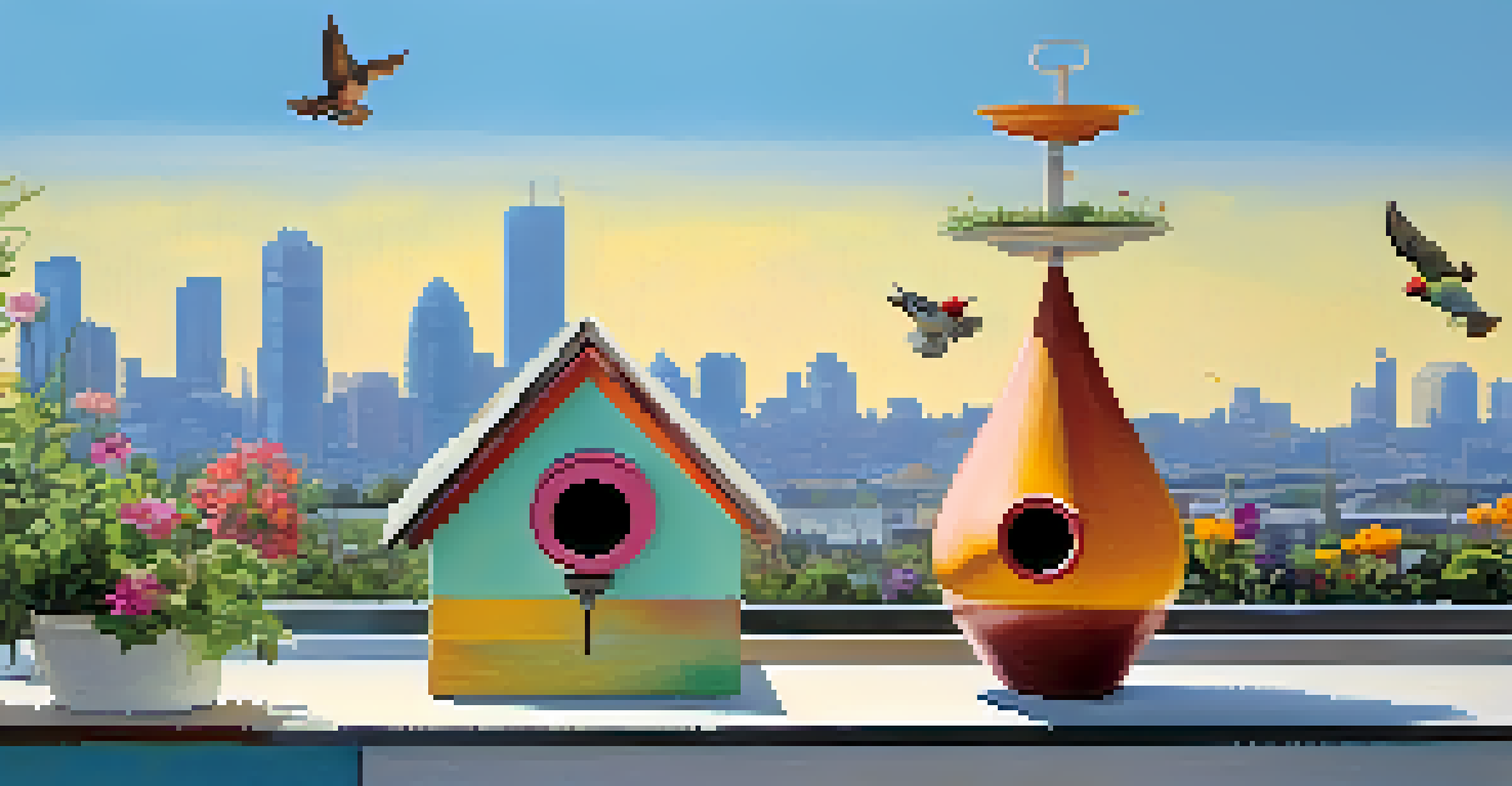The Best Birdhouse Designs for Urban Environments

Understanding Urban Birdhouse Needs
Urban environments present unique challenges for birds, such as limited nesting sites and increased predators. Therefore, it’s essential to design birdhouses that cater to these conditions. Urban birds, like sparrows and bluebirds, require safe havens that mimic their natural habitats, even in concrete jungles.
The best way to attract birds is to provide them with proper shelter.
Additionally, urban areas often have noise and pollution that can deter birds from nesting. A well-designed birdhouse can minimize these factors, providing a quiet, serene space for birds to thrive. These considerations help ensure that our feathered friends have a chance to flourish amidst the hustle and bustle.
By understanding the specific needs of urban birds, we can create birdhouses that not only attract them but also support their lifestyle. This means using appropriate materials, sizes, and features that facilitate easy access and protection.
Compact Designs for Limited Spaces
In urban settings, space can be a premium, which makes compact birdhouse designs particularly appealing. Vertical birdhouses, for instance, can maximize height while minimizing the footprint on your balcony or yard. These clever designs can house multiple bird families in a smaller area, making them ideal for crowded neighborhoods.

Another great option is the wall-mounted birdhouse, which can be attached to fences or walls, saving precious ground space. They often come in sleek, modern designs that fit well with urban aesthetics, allowing you to enhance your outdoor decor while supporting local wildlife.
Urban Birdhouses Need Special Design
Birdhouses in urban areas must be thoughtfully designed to cater to birds' needs for safety, comfort, and accessibility.
Compact designs not only save space but also make it easier for residents to install and maintain their birdhouses. With the right design, you can attract birds without overwhelming your urban landscape.
Eco-Friendly Materials for Birdhouses
Using eco-friendly materials in birdhouse construction is not just good for the environment; it also appeals to eco-conscious urban residents. Reclaimed wood, for example, provides a rustic look while reducing waste. It’s sturdy, well-insulated, and free from harmful chemicals, making it a safe choice for nesting birds.
By fostering a love for nature and wildlife, we can create a better world for all living creatures.
Another sustainable option is bamboo, which is lightweight and naturally resistant to moisture and pests. Bamboo birdhouses can blend seamlessly into green urban spaces, providing birds with a cozy place to call home without the environmental impact of synthetic materials.
Choosing eco-friendly materials helps create a healthier habitat for birds and promotes sustainability in urban environments. It’s a win-win situation for both the birds and those who cherish nature in the city.
Innovative Birdhouse Features
Incorporating innovative features into birdhouse designs can significantly enhance their appeal. For instance, birdhouses equipped with ventilation holes and drainage systems can help regulate temperature and moisture, creating a comfortable environment for nesting. This is especially important in urban areas where temperatures can fluctuate dramatically.
Some designs even include built-in feeding stations or water sources, making them attractive not just as homes but as all-in-one habitats for birds. These added features can encourage more birds to visit and stay in your urban garden.
Compact Structures Save Space
Compact birdhouse designs, like vertical or wall-mounted options, are ideal for urban settings where space is limited.
By thinking outside the box and adding unique elements to birdhouses, you can create functional and inviting spaces for birds, while also enjoying the beauty of nature in your urban environment.
Color and Style Considerations
When it comes to birdhouses, color and style can play a significant role in attracting birds. Bright, natural colors that mimic the hues found in nature can help draw in various bird species. However, it’s also important to consider the aesthetics of the neighborhood, ensuring that your birdhouse complements the urban landscape.
For example, modern geometric designs in muted colors can appeal to design-savvy urban dwellers while providing a suitable habitat for birds. Mixing style with function can create a birdhouse that not only looks good but also serves its purpose effectively.
Ultimately, the right color and style can make your birdhouse a striking feature in your outdoor space while enticing birds to make it their home.
Safety Features for Urban Birdhouses
Safety is paramount for birds nesting in urban settings, where dangers like cats and harsh weather conditions are prevalent. Incorporating features like predator guards and sturdy construction can protect vulnerable nests from potential threats. Additionally, ensuring that the entrance hole is appropriately sized can keep larger predators at bay.
Another safety consideration is placement; birdhouses should be positioned away from busy areas where they might be disturbed. Ideally, they should be placed at least 5-10 feet off the ground, providing a safe haven for nesting birds.
Safety Features Are Essential
Incorporating safety features like predator guards and proper placement is crucial for protecting urban nesting birds.
By prioritizing safety in urban birdhouse designs, you help create a secure environment for birds to raise their young, thus playing a crucial part in supporting local wildlife.
Maintaining Urban Birdhouses
Regular maintenance is essential for keeping urban birdhouses in good condition and ensuring they remain safe for birds. Cleaning the birdhouse after the nesting season helps prevent the spread of diseases and parasites. It’s a simple task that can go a long way in promoting the health of local bird populations.
In addition to cleaning, checking for wear and tear is crucial, especially in urban environments where pollution can accelerate deterioration. Keeping an eye on the structure and making necessary repairs can prolong the life of the birdhouse and continue attracting birds year after year.

By committing to maintenance, urban birdhouse owners can foster a thriving bird community while enjoying the beauty and chirps of their feathered neighbors.